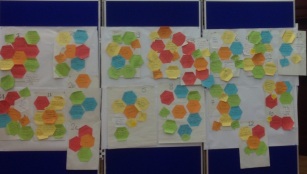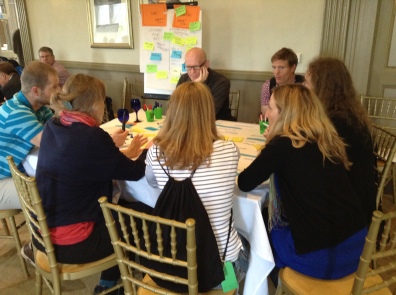Complex projects will involve teams from different parts of your organisation or from multiple organisations, some of whom could be competitors on a different project. It would be hoped that the common goal of project completion will encourage the different interests to work together to resolve any problems quickly so that the task gets done on time and to specification. Our experience has been that hope alone is rarely enough for effective collaboration to thrive.
“Although teams that are large, virtual, diverse, and composed of highly educated specialists are increasingly crucial with challenging projects, those same four characteristics make it hard for teams to get anything done. To put it another way, the qualities required for success are the same qualities that undermine success” Gratton and Erickson, Harvard Business Review, Nov. 2007
If you want your team to work successfully in a collaborative manner you will need to take positive action to embed the behaviours that will encourage co-operative and will overcome the natural tendencies to privatize knowledge and to be competitive.

You could put on a training programme but this can often be theoretically and not always applied in practice we find it better to make a number of live interventions once a project team has mobilised. Of course these interventions will only work if the culture of all the organisations involved are supportive to collaboration and if this is something that senior leaders consciously demonstrate during their work. If the culture is in place then our three easy interventions will help you as the project leader to drive the change you want so that collaboration becomes a key element to your project success.
Stage One: Establishing the Collaborative Team
This stage will involve a number of activities but a crucial element will be a face to face event. The value of face to face conversations are hard to fully replicate in other ways so unless it is just impossible find a time and place to physically connect. The amount of time for this varies but often the 24 hour retreat – 13.00 – to 13.00 works well, as it provides time to connect socially as well as professionally.
This event is an opportunity for your team to work collaboratively together on a number of real challenges and tasks you need to do to kick off the project. This will include the following activities:
- Setting the project vision – appreciating the different expectations of success can help your team to find “win win” solutions to challenges that they will face during the life time of your project.
- Exploring Expertise- highly intelligent and skilled professionals often do not explain their expertise in an accessible manner and this can be a source of conflict when their expertise is not fully utilised later in the project. Providing time for your team to share and appreciate the range of skills and expertise they have will work much better than playing any number of “trust games”
- Exploring Behavioural Expectations – this is a really important activity because it will involve you sharing your expectations of behaviours to support collaboration. You can use the results of this activity later on in project reviews to provide an easy forum for team members to address behaviour that is not supporting the project.

Stage 2 – Project Team Collaboration Reviews
The number and timings of these collaborative reviews will vary but the critical element is that there is space provided to specifically explore collaboration and not just talk about the project goals and milestones. Sometimes these reviews are done virtually and sometimes a combination of virtual team meet ups and face to face sessions are used.
- Reviewing the Vision – you can review the vision from the start-up session and ask the team to identify the activities that have directly addressed the overall vision for the project. You can explore alignment between the collaborative behaviours and the project vision.
- Updating Expertise– sharing learning and identifying any gaps in knowledge, skills or behaviour will help your team make better use of its resources. A useful method for this are action learning groups. These give you a face to face or virtual space to explore learning from the project and identify any gaps in knowledge/skills.
- Reviewing and resetting expectations – you can covert the discussion about behaviour in the start up to a quick “temperature” checking tool. Your team can self assess the levels of collaboration in the project team. You can collate the resut and share these with the team to help you all explore both successes and challenges in behaviours and agree a options to further develop your collaborative work.

Stage 3 – Celebrating the Collaboration
A frequently overlooked intervention is an opportunity to review and celebrate your project collaboration . This can be done with a series of interventions, it does not have to be a face to face event. Some elements you will find useful include:
- Reviewing the Vision– reflecting on your shared vision at your first project session and exploring how this differs from the project outcome. This is a great time for you to ask questions about the difference between aspirations and the realities of projects and to explore the impact of this mismatch
- Celebrating expertise and skills – during the project your team will have developed their skills and expertise so it is about providing a way of charting this growth in a shared format.
- Reviewing behaviour – if your team are likely to bid for future work on collaborative frameworks then taking time to honestly reflect on the collaborative behaviours shown is a the best way to prepare your team to perform at even higher levels on the next project.
- Recording the story of the project creating a story board of all the photos and key stages to your project can be a good way of celebrating your journey. This can be done easily using an on-line pinboard facility.

The interventions outlined above are things you can do as the project leader. You may to engage a neutral facilitator to work with you so that you can participate in the discussions and leave someone else to worry about the process. Whether you work independently or with a facilitator you will find that giving this focus on collaboration will help your team avoid some of the conflict that can often set project team behind schedule.
If you want to have an informal, free chat with one of our team we have facilitators working across the the UK and Europe and we can call by for a face to face dicussion or connect virtually with you to talk about improving collaboration
Christine Bell






